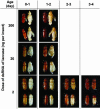Laccase 2 is the phenoloxidase gene required for beetle cuticle tanning
- PMID: 16076951
- PMCID: PMC1183588
- DOI: 10.1073/pnas.0504982102
Laccase 2 is the phenoloxidase gene required for beetle cuticle tanning
Abstract
Cuticle tanning (or sclerotization and pigmentation) in invertebrates involves the oxidative conjugation of proteins, which renders them insoluble and hardens and darkens the color of the exoskeleton. Two kinds of phenoloxidases, laccase and tyrosinase, have been proposed to participate in tanning, but proof of the true identity of the enzyme(s) responsible for this process has been elusive. We report the cloning of cDNAs for laccases and tyrosinases from the red flour beetle, Tribolium castaneum, as well as their developmental patterns of expression. To test for the involvement of these types of enzymes in cuticle tanning, we performed RNA interference experiments to decrease the levels of individual phenoloxidases. Normal phenotypes were obtained after dsRNA-mediated transcript depletion for all phenoloxidases tested, with the exception of laccase 2. Insects injected with dsRNA for the laccase 2 gene failed to tan, were soft-bodied and deformed, and subsequently died in a dsRNA dose-dependent fashion. The results presented here support the hypothesis that two isoforms of laccase 2 generated by alternative splicing catalyze larval, pupal, and adult cuticle tanning in Tribolium.
Figures





References
-
- Pyror, M. G. M. (1940) Proc. R. Soc. London Ser. B 128, 393–407.
-
- Hopkins, T. L. & Kramer, K. J. (1992) Ann. Rev. Entomol. 37, 273–302.
-
- Kramer, K. J., Kanost, M. R., Hopkins, T. L., Jiang, H., Zhu, Y. C., Xu, R., Kerwin, J. L. & Turecek, F. (2001) Tetrahedron 57, 385–392.
-
- Andersen, S. O. (2005) in Comprehensive Molecular Insect Science, eds. Gilbert, L. I., Iatrou, K. & Gill, S. (Elsevier, Oxford, U.K.), Vol. 4, pp. 145–170.
-
- Locke, M. & Krishnan, N. (1971) Tissue Cell 3, 103–126. - PubMed
Publication types
MeSH terms
Substances
Associated data
- Actions
- Actions
- Actions
- Actions
- Actions
LinkOut - more resources
Full Text Sources
Other Literature Sources

